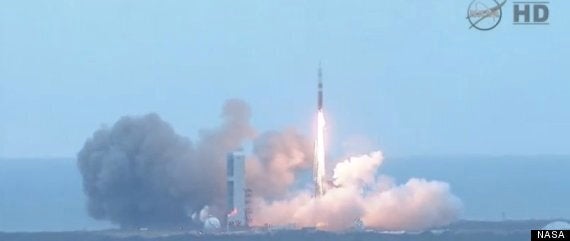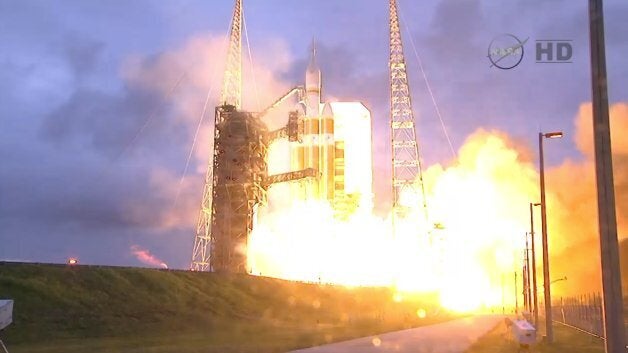NASA's 'Mars spacecraft' Orion has splashed down in the Pacific Ocean following a successful four-hour flight and textbook launch from Cape Canaveral in Florida.
The next-generation "Mars Ship" capsule launched atop a Delta IV heavy rocket, and completed a relatively short, but extreme, journey around the Earth before its 'trial by fire' return through the atmosphere.
The craft was meant to launch on Thursday, but the lift-off was scrubbed following a series of problems including high winds.
Nasa hopes to use Orion to put astronauts back on the moon by 2020 and take them to Mars in the 2030s. A midway mission to an asteroid is also on the cards.
READ MORE:All You Need To Know About Orion

The rocket that launched Orion from Cape Canaveral Air Force Station was the largest currently in service in the US, a Delta IV Heavy.
At lift off, its three RS-68 engines together produced about two million pounds of thrust.
Mission controllers said Orion reached its peak altitude of 3,604 statute miles above the Earth at 3.11pm UK time.
At that point, it was further from the Earth than any manned space vehicle had been since the Apollo 17 mission 42 years ago.
At 3.28pm UK time, the Orion capsule separated from its power and propulsion unit, or service module, prior to the "trial by fire" descent through the Earth's atmosphere.
It splashed down at around 4.30pm UK time.

Orion is the most advanced space craft ever built, NASA has said.
It is designed to carry up to seven astronauts into space, where it will eventually form the cockpit of larger spacecraft.
The first test flight - EFT-1 - was unmanned, and is carrying hundreds of sensors designed to examine every element of the journey, including two passes through the dangerous 'Van Allen' radiation belt about 3,600 miles above Earth.
The craft also carried a range of other objects - including an Iron Man doll and a model of the DeLorean time machine.
At the end of the flight the capsule, that on future flights will contain a four-man crew, entered the atmosphere at 20,000mph and splashed down into the Pacific ocean off Baja California.
NASA has said that the craft will eventually form the core of its first manned missions to the Moon since 1972, as well as trips to asteroids and eventually to Mars.
But sceptics have said that those missions would require huge amounts of new funding, and that on its own the Orion capsule is not able to complete those long-haul missions through space.
Astronaut Rex Waldheim, who flew the last shuttle mission in 2011 and is helping to design Orion's interior systems, told Nasa TV: "The ultimate destination is Mars. Everybody wants to go to Mars.
"It's important to go there and establish a presence on another planet so we become a multi-planetary species."
He added: "Now we've turned the corner and Orion is flying, and it's a very exciting time."
The next Orion flight, Exploration Mission One (EM-1) will involve an unmanned trip around the moon in 2017 or 18.
For this mission, the spacecraft will be launched by Nasa's new Space Launch System (SLS) rocket which is now in final stages of development. The SLS will be the most powerful rocket ever built and capable of producing 20% more thrust than the mighty Saturn V that sent astronauts to the moon.
Waldheim promised that the SLS would be "spectacular". The future of Orion becomes more uncertain after EM-1, but could embrace President Barack Obama's goal to send a crewed spacecraft to an asteroid by the mid-2020s.
Earlier plans to land astronauts on the moon using Orion were shelved, mainly on cost grounds.
Instead the provisional plan for Exploration Mission Two (EM-2) is now for an Orion crew to spend three to four days in lunar orbit before returning home.
Depending on what is finally decided, they may also rendezvous with a small asteroid previously "captured" and placed in orbit around the moon by a robot tug.
EM-2 is expected to take place in around 2021. It will pave the way for further missions culminating in a manned trip to Mars some time in the 2030s.
Nasa has its sights fixed on the Red Planet rather than the moon. If future astronauts do land on the moon, they may not be from the American space agency.
